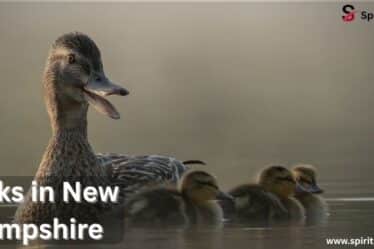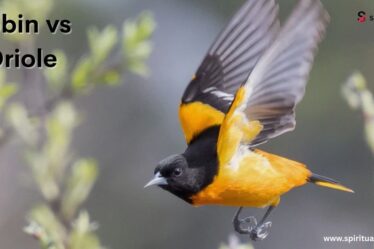
Ducks in Colorado are a common sight throughout the year, especially in the state’s beautiful wetlands, lakes, and rivers. Whether you’re an avid birdwatcher or just love nature, Colorado offers plenty of opportunities to spot a wide variety of ducks. From Mallards to Blue-winged Teal, these birds thrive in the state’s diverse ecosystems. Ducks in Colorado can be seen during migration seasons, in summer breeding grounds, and even in winter. If you’re looking to experience the charm of these birds, the best time to see them is during their migration periods, when many species pass through the state. Discover more about ducks in Colorado and where to find them!
Mallard
The Mallard (Anas platyrhynchos) is the most common and familiar duck in Colorado. Males have a bright green head, white neck ring, and a chestnut-brown chest, while females are mottled brown, allowing them to blend into tall grass and vegetation for nesting. These ducks are found in ponds, lakes, rivers, and even urban parks. They are ground nesters, laying 8–13 eggs which hatch in about 28 days. Mallards are omnivorous, feeding on aquatic plants, insects, seeds, crustaceans, and even small fish. Their ability to adapt makes them thrive in both rural wetlands and urban areas. With a body length of 50–65 cm, wingspan of 81–98 cm, and weight ranging from 700–1600 g, Mallards live around 5–10 years and are listed as Least Concern for conservation.
Blue-winged Teal
The Blue-winged Teal (Spatula discors) is a small, fast, and migratory dabbling duck. Males have a slate-blue head, a distinct white crescent on the face, and brown appearance, while females are mottled with brown and tan. They are commonly found in shallow freshwater habitats like marshes and ponds with dense vegetation. These ducks lay 6–14 eggs, which hatch in about 24 days. Blue-winged Teals feed on aquatic invertebrates, especially during breeding season. Measuring 40–47 cm in length, with a wingspan of 58–63 cm and weighing 280–420 g, they live up to 5–10 years and are classified as Least Concern.
Bufflehead
Buffleheads are small diving ducks with large heads and striking coloration. Males have white chests, white flanks, a large white patch on the head, and dark backs with iridescent purple-green plumage. Females are brownish with a white cheek patch. These ducks are excellent divers, often foraging underwater for crustaceans and aquatic invertebrates. They nest in tree cavities, often using old holes made by Northern Flickers or Pileated Woodpeckers. Buffleheads are also known for their squeaky whistle calls.

Cinnamon Teal
This duck is named for the male’s rich cinnamon-red plumage. Females are mottled brown, similar to Blue-winged Teal. These ducks are common in shallow marshes and wetlands, preferring areas with thick reeds and grasses. They feed on aquatic vegetation, seeds, and small invertebrates. Their spatula-shaped bill helps in sifting food from the water. Cinnamon Teals are early migrants, often among the first to arrive and depart during migration seasons.
Green-winged Teal
The Green-winged Teal is the smallest dabbling duck in Colorado. Males are easily identified by the green patch on the wings and chestnut-colored heads with a green stripe behind the eyes. Females are a more subdued mottled brown. These ducks forage in shallow waters, feeding on seeds, aquatic plants, and small invertebrates. Their small size and rapid flight make them a challenge to spot, but they are widespread and common in wetlands during migration.
Northern Shoveler
With its distinctively large, spoon-shaped bill, the Northern Shoveler is easy to identify. Males display green heads, white chests, and rusty flanks, while females are brown with an oversized bill. They use their unique bill to filter food such as crustaceans, mollusks, and aquatic insects from the water. These ducks are often seen swimming in circles, working as a group to stir up sediment and access hidden food.
Ring-necked Duck
The Ring-necked Duck is a medium-sized diving duck with a dark head, a slight purplish sheen, and a distinct white ring near the bill. Despite its name, the ring on the neck is hard to see. They feed by diving underwater for aquatic plants and invertebrates. These ducks prefer quiet lakes and ponds, especially those with dense vegetation.

Barrow’s Goldeneye
This diving duck is less common but can be found in the mountain lakes of Colorado. Males have a dark head with a crescent-shaped white spot near the bill, while females are brown with a yellow bill. These ducks nest in tree cavities near water and feed on insects, crustaceans, and fish eggs. They are typically seen in colder, higher elevation waters.
Common Merganser
The Common Merganser is a large fish-eating duck with a sleek body. Males have a white body, black back, and a dark green head, while females are gray with a rusty-brown head and a short crest. These ducks dive for small fish, using their serrated bills to catch slippery prey. They nest in tree cavities and are often seen along fast-moving rivers and mountain streams.
Long-tailed Duck
Rare in Colorado, the Long-tailed Duck is a sea duck more commonly found in coastal areas, but sometimes seen on large reservoirs. Males have long tail feathers, white underparts, and black backs, while females are brown and white. They dive deeply for aquatic vegetation and invertebrates.
Northern Pintail
The Northern Pintail is a graceful duck with a slender neck and long tail feathers. Males have cinnamon-brown heads, white necks, and gray bodies, while females are tan with rufous-brown plumage. Pintails prefer shallow wetlands, wildlife refuges, and edges of lakes. They forage in farm fields, eating leftover wheat, barley, rice, and corn. Their flight is swift and direct, reaching speeds up to 48 mph, and they often migrate at night.

Canvasback
The Canvasback is a large diving duck known for its wedge-shaped head, red-brown head, and red eyes. It has a black chest, black tail, and a pale gray body. Females are lighter with black eyes. These ducks dive up to 7 feet deep to feed on plant tubers, insects, and mussels. They are found in wetlands, though development and habitat loss threaten their numbers.
Hooded Merganser
This small, striking duck has a large black crest with a white patch, giving it a mohawk-like appearance. Males have yellow eyes and a slender bill, while females are brown with a lighter crest. They dive to catch small fish, crayfish, and aquatic insects, swallowing them whole. Their eyes are specially adapted to see clearly underwater. Like others, they often lay eggs in other nests, and nests can have over 40 eggs.
Red-breasted Merganser
The Red-breasted Merganser has a spiky crest, reddish breast, and thin serrated bill. Males are more colorful, while females are grayish with a rusty head. These ducks dive in coastal areas, but occasionally show up in large inland lakes and rivers during migration. They feed mainly on fish and are among the fastest flying ducks.
Redhead
Redheads have a steep forehead, cinnamon-red head, and yellow eyes. Males have gray bodies and black chests, while females are brownish with a paler face. Redheads are social ducks, often found in large flocks in winter. They sometimes practice brood parasitism, laying eggs in nests of Mallards, Canvasbacks, or Northern Shovelers.
Common Goldeneye
The Common Goldeneye has a dark green head, bright yellow eye, and a white cheek patch. The body is mostly white with a black back. Females are brown-headed with a short bill. They are expert divers, feeding on fish, invertebrates, and submerged vegetation. Their wingbeats produce a distinctive whistling sound in flight, earning them the nickname “whistler.”
Barr Lake State Park (Brighton)
Located just northeast of Denver, Barr Lake State Park is a birdwatching hotspot and a prime location for spotting a variety of dabbling and diving ducks, especially during spring and fall migrations. The park features a 9-mile trail around the lake, a boardwalk, and an educational nature center.
Monte Vista National Wildlife Refuge (San Luis Valley)
This high-elevation wetland refuge is a crucial stopover for migratory waterfowl, especially ducks, geese, and sandhill cranes. The refuge is particularly active during the spring migration, and it provides shallow marshes, open water, and grasslands that support a wide variety of duck species, including Northern Pintail, Green-winged Teal, and Canvasback.

John Martin Reservoir (Southeastern Colorado)
Known as the “jewel of the plains,” this large reservoir and surrounding wetlands attract an impressive diversity of waterfowl. Ducks such as Redheads, Mallards, and Northern Shovelers are common, especially in fall and winter. Birders often visit in the cooler months to catch a glimpse of rare migratory species.
Chatfield State Park (Littleton)
Just southwest of Denver, Chatfield is popular with both people and birds. Its large reservoir, marshes, and creek inlets are home to ducks year-round. In winter, you’ll often see flocks of Common Mergansers and Goldeneyes on the water.
Walden Reservoir and State Wildlife Area (North Park)
In the mountain basin of North Park, this remote area is one of the best places in the state for breeding waterfowl. Look for Barrow’s Goldeneye, Bufflehead, and Northern Pintail during the spring and summer months. The lush grasslands, alpine lakes, and wet meadows are teeming with bird activity.
South Platte River Corridor
The South Platte River flows through both rural and urban environments, providing critical habitat for ducks, especially in metro Denver. Various stretches of the river — particularly around Platte River Greenway, Adams County Fairgrounds, and Englewood’s Centennial Park — offer great duck-watching, especially for Mallards, Teals, and Mergansers.
Highline Lake State Park (Western Colorado)
Located near Fruita, this state park attracts a wide range of migratory waterfowl. It’s particularly notable for wintering ducks like Redheads, Northern Shovelers, and Gadwalls. The lake and surrounding wetlands make it a peaceful spot for early morning birdwatching.
Best Time of Year to See Ducks in Colorado
Colorado’s diverse ecosystems attract ducks year-round, but the best time to observe these fascinating birds depends on migration patterns and the weather. Understanding the seasons can significantly enhance your duck-watching experience.
Spring and Fall | The Migration Seasons
During spring and fall, Colorado becomes a critical stopping point for migrating ducks. Spring migration usually peaks from March to May, when ducks are returning north to their breeding grounds. On the other hand, fall migration (typically from September to November) sees a surge of ducks heading south to warmer climates.
These migration periods bring a wide variety of duck species to Colorado’s wetlands, lakes, and rivers. You can expect to see ducks such as Blue-winged Teal, Northern Shoveler, Common Goldeneye, and Redhead in these seasons. Wetland habitats and larger reservoirs are excellent spots to observe these birds during their journey. Many birdwatchers flock to areas like Monte Vista National Wildlife Refuge or Barr Lake State Park, as they offer prime viewing locations.
Winter-Duck Species on the Move
Winter (December through February) is another exciting season for duck watching in Colorado, especially if you enjoy observing diving ducks. As temperatures drop, certain species of ducks, such as Common Mergansers, Canvasbacks, and Bufflehead, will seek refuge in Colorado’s open water habitats, like John Martin Reservoir or Chatfield State Park. These ducks tend to remain in the state throughout the colder months due to the relatively mild winters compared to other northern regions.
For those hoping to see resident ducks that stick around year-round, species such as Mallards and Northern Pintails can be found in a variety of habitats from urban parks to more remote wetlands. The mild winters in urban areas make them especially attractive to ducks that prefer to stay in rural wetlands.

Summer- A Time for Breeding
In the summer months, Colorado’s wetlands and rivers are home to a range of breeding ducks. During this time, you may see more Mallards nesting in the tall grasses along lakeshores or Blue-winged Teals in shallow ponds. While the birdwatching experience is quieter in summer, it’s the best time to witness ducks in their breeding plumage and observe their natural behaviors like nesting and parenting.
Breeding often occurs in dense vegetation found near the shorelines of wetlands, making areas like Walden Reservoir or Highline Lake State Park ideal places to spot newly hatched ducklings following their mothers around the water.
Conclusion
If you’re a bird enthusiast or just someone who loves nature, Colorado is a fantastic destination for spotting a diverse range of duck species. Whether you’re on a spring migration expedition or observing the quieter days of winter, the state’s wetlands, lakes, and rivers offer unique opportunities for duck-watching. From Mallards to Barrow’s Goldeneye and Northern Pintails, there’s something special about watching these fascinating creatures in their natural habitat.
The key to enjoying ducks in Colorado is knowing where to go and when to visit. Spring and fall migration periods bring a wave of migrating ducks, while winter offers a chance to spot more resident species. Ducks in Colorado are also protected by hunting regulations and ongoing conservation efforts that help preserve their aquatic habitats. So grab your binoculars, head to one of Colorado’s many beautiful wetlands, and enjoy the vibrant duck populations the state has to offer.



